Back in January I wrote a post about my most favorite non-Japanese cartoon. Today I’m following up with that idea and writing about my most favorite non-Japanese comic. I’ve always been an avid fan of animated movies and TV shows, but I’ve only read a few non-Japanese comics. I never had that much interest in comic strips, but this one stands out to me in particular…
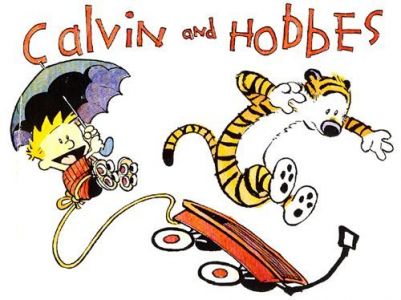
Although I got my first look at Bill Watterson’s Calvin and Hobbes in the 90s, it didn’t become my favorite comic until some years later. A friend had bought me a Calvin and Hobbes collection when I was in elementary school. Not knowing that it’s actually a mature comic that uses a lot of difficult words, abstract concepts, satire, and deep themes, I didn’t understand it much during my initial reading. Thus I put it aside, and throughout my childhood, Garfield was always my favorite comic.
As I got older however, the humor in Garfield started to lose its appeal to me. Thankfully I hadn’t given away that Calvin and Hobbes collection despite not touching it for many years. One day I decided to read it again, and this time I understood all the humor and subject matter. I thought to myself “No wonder I didn’t like it back then. I wasn’t old enough for it.”
What makes Calvin and Hobbes so unique and creative is that it revolves around Calvin, an immature, disobedient kid who’s also intelligent and thoughtful beyond his years, and his tiger Hobbes. To Calvin, Hobbes is a real walking, talking tiger, while he appears to be a normal stuffed animal tiger to everyone else.

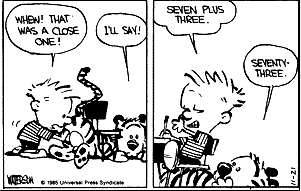

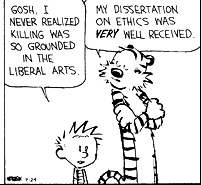
Watterson’s reason for making this “gimmick” in the strip is quite interesting. He states in the Calvin and Hobbes Tenth Anniversary Book…
“I don’t think of Hobbes as a doll that miraculously comes to life when Calvin’s around. Neither do I think of Hobbes as the product of Calvin’s imagination. The nature of Hobbes’ reality doesn’t interest me, and each story goes out of its way to avoid resolving the issue. Calvin sees Hobbes one way, and everyone else sees Hobbes another way. I show two versions of reality, and each makes complete sense to the participant who sees it. I think that’s how life works. None of us sees the world in exactly the same way, and I just draw that literally in the strip. Hobbes is more about the subjective nature of reality than about dolls coming to life.”
This concept of everyone viewing reality different is a central part of the strip’s appeal. Often times, Watterson will draw the strip in a different style, reflecting what Calvin is seeing in his reality at the time, as the strips below show. Usually it’s not until the last panel that we return to everyone else’s reality.


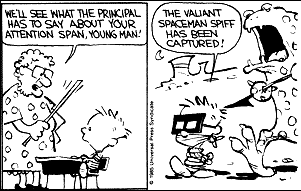

Sometimes a continuing story will play out over the course of many strips. They’ll often feature Calvin and Hobbes going on all sorts of grand adventures, from magic carpet rides, going into outer space, being transformed or duplicated, and many other fantasies.
All of these occur in Calvin’s reality of course, but Watterson presents them in such a way that, even though we know this is only Calvin’s imaginative view of the world, we can’t help but feel a yearning to return to those times of childhood daydreams and fantasies where anything is possible. Calvin’s adult-like knowledge and dialogue allow us to relate to him as more than just a kid, but the detailed, creative fantasies that Watterson creates for him reminds us that we should try to keep that inner child part of us intact. Because of all this, I believe Calvin and Hobbes is best enjoyed by adults.

In addition to presenting these vivid stories of Calvin’s amusing childhood realities, there are also many hilarious and often satirical strips…

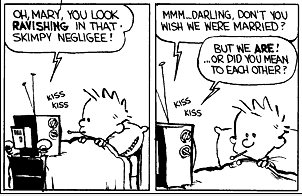
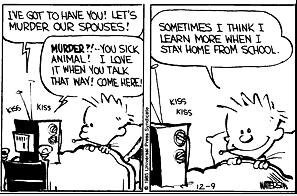
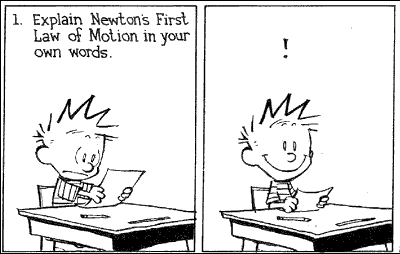
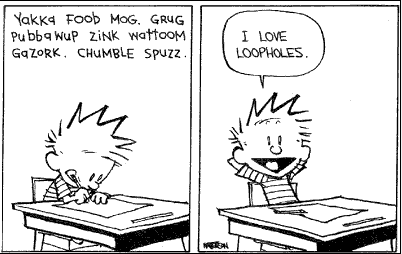
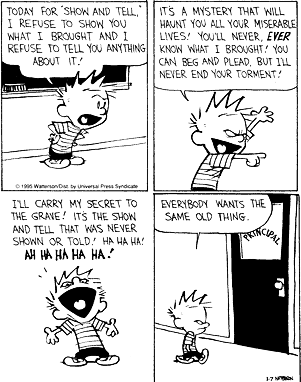

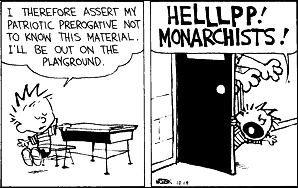
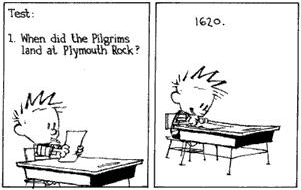
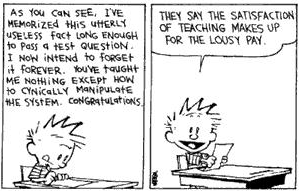
The strip can also become philosophical, even touching and emotional…

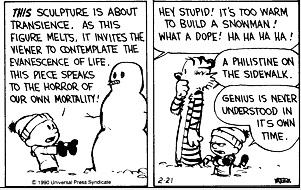



Although it only ran for ten years from 1985 to 1995, the Calvin and Hobbes comic is unlike any other. It not only has the clever satirical and slaptick humor present in most other American comic strips, but it also presents a creative view of reality through the eyes of the endlessly fantasizing Calvin. His mind takes him from simple, amusing adventures that exist in everyone’s reality, such as thwarting his babysitter and talking back to his teacher, to those that exist solely in his reality, such as going on space adventures, becoming a rampaging dinosaur, and having snowball fights with Hobbes. From philosophical and satirical musings, to all-around fun and fantasizing, Calvin and Hobbes embodies so many themes in such a simple comic. I get something different out of it each time I read it.
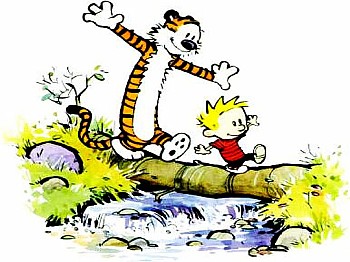
Best comic strip ever. I don’t think that there’s many out there that can capture the wit and deep meanings that Watterson imparts through his strips. I loved it as a kid and now that I’m much much older, I find that reading through the collections that I have at home still pack with it a sense of relevance, which goes to show how well the strip resonates with people from many walks of life.
Really wish Watterson the best and do miss his unique take upon the world. He’s inspired me a great deal through his art and the messages contained therein.
@ zzeroparticle
I agree with everything you say – Calvin and Hobbes is simply one of a kind. Since I didn’t like it much on my first reading, it obviously requires a certain level of maturity in order to be fully appreciated, despite it being about a kid and a tiger =P So many of Watterson’s ideas and catchy lines have stuck in my head over the years.
goddam I loved Calvin and Hobbes (and still do); probably spent hours when I was younger reading through all the collections.
Other 4-panel comics I liked include Zits and Garfield; I also like American graphic novels (superhero ones excepted).
One of the reasons I read this blog is because most of your posts are pretty much my thoughts as well.
@ Prooof
I still like Garfield, but like I said in the post, not as much as I used to, especially compared to Calvin and Hobbes. I think the only other American comic besides these two that I read somewhat regularly was The Far Side, which can be funny but doesn’t have the same appeal because it doesn’t continuously use the same characters.
I’m not sure why I never got into any superhero comics, especially when I was a kid before I knew about anime/manga. I think I just didn’t encounter them as much for whatever reason.
Batman and Fable all the way, but strip-wise I’ve been a dedicated follower of Get Fuzzy for a few years now.
@ Saere
I watched a little of the Batman animated TV series, but other than that I’m not familiar with the ones you mentioned. Sorry =/
I also like Calvin and Hobbes…
but hey, why they didn’t make a show of that?hahahahahah!
@ ~xxx
Yeah, a cartoon of Calvin and Hobbes would have been great! I think the reason they didn’t make one though is because the strip is very dialogue-heavy, and it’s probably hard to capture the effect of switching between what Calvin sees and what everyone else sees in actual animation.
My parents had a Calvin and Hobbes compilation book I read all the time. My roommate’s got a Far Side collection I read through when we’re at his dad’s house. Also add to that the fact that my college Biology teacher (he and his wife are family friends at this point) used to put Far Side comics next to stations during the lab tests!
In terms of more western comics, I like to tell people who are interested to check out Nextwave. Very zany and fun to read.
@ Robert
Besides Garfield and Calvin and Hobbes, the only other non-Japanese comic I read somewhat frequently was The Far Side. I remember it being popular with some of my teachers at school too. They had the daily tear-off calendars or random Far Side comics posted somewhere in their classrooms =)
Calvin and Hobbes is just great. I agree that its humor is more timeless than that of Garfield.
Either way, there are many other great comics/graphic novels out there ya know.
Huge classics like ‘Maus’ and ‘The Contract With God’ (trilogy) but also newer brilliant ones like Logicomix or the travelling logs of Guy Delisle (Pyongyang and Birma)
Then there’s Persepolis, Blankets (Craig Thompson) and so on.
Frankly, thesedays you can find comic books on virtually all subjects hailing from all corners of the globe. I’m quite amazed sometimes how some readers focus all their attention solely on manga whilst the artform has got so many equally interesting expressions. Heck, some even run out of good manga to read and begin reading substandard series…whilst all they have to do is broaden their view.
Some of my favourite comic writers are American, Will Eisner and Art Spiegelman for example, altough I must say that the typical American comic (Marvel-style) doesn’t really resonate with me. Anyway, everyone should look into comics. There’s nothing quite as fulfilling as a big-ass , personal comic collection with all the best the world has to offer.
Anyway it doesn’t really surprise me that Calvin and Hobbes is the comic you connect most with. After all just as in other series like Yotsubato, the stuff people think and do in their early years tend to be pretty universal…it makes it easier to appreciate if you share some common ground.
@ Reason
Wow, I haven’t heard of most any of those comics you mentioned. I’m actually not much of a comic person (I’ve barely read any manga actually) and much prefer TV/movie animation. But maybe one day I’ll get more into comics.